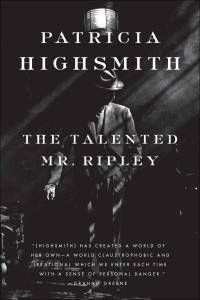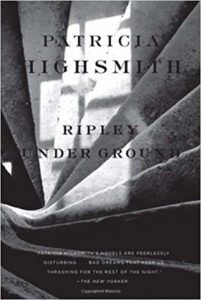There are, of course, questions to contemplate about what material will make it into the series. One has already been raised: Will Ripley be gay? I want to delve into that, but there’s a lot more to discuss! Below are some specific things that I’d like to make it to the small screen. This show may not reach the level of Killing Eve as a stylish crime series featuring obsessive queer or queer-ish attachments. I don’t know if I would even want it to. But when it comes to Ripley on TV, here’s what I’d like to see.
Sensitively Rendered Queer Sexuality
via GIPHY Okay, let’s get this out of the way first. Now, I’m not in the least against creative adaptations. However, I would personally like to see Ripley’s sexuality portrayed more or less as it is in Highsmith’s original. If only because that hasn’t really been done yet, so far as I’m aware. In Anthony Minghella’s movie starring Matt Damon, which is the screen adaptation most people are probably familiar with, Ripley comes across as a tortured variety of criminal. He appears consumed by his attraction to Dickie Greenleaf, whose father hired Ripley to bring back him from Europe. In Highsmith’s The Talented Mr. Ripley, by contrast, Tom is relatively composed about matters of sexuality. He does feel intensely drawn to Dickie, but he’s more cold-blooded in his eventual attempt to take over Dickie’s identity. He isn’t exactly skulking around sniffing at Dickie’s pocket squares. This doesn’t necessarily mean that he’s not sexually repressed. But regardless, I would prefer that he not be portrayed in a way that equates queerness with violence and suffering. Popular movies and TV have a way of using queerness as a tragic plot point, and I would really, really like for that not to happen here. I can appreciate that Highsmith herself felt compelled to remain closeted during her life, and that this probably affected her writing. And truthfully, I wouldn’t necessarily mind if the creators shifted the tone and content of the show to make Ripley more explicitly queer. But I think this would have to be done delicately in order to work well. I also think it’s important to note that the question of whether Tom Ripley will be gay in itself seems insufficient. If we’re thinking about how the character could serve LGBTQIA+ representation, it makes sense to consider bi/pansexual and asexual representation specifically. We can’t say for sure what Tom’s sexual orientation is in the books, but we can note a few things: I think it would be great if the show maintained a consciousness of Tom’s probable queerness. I would like it to. At the same time, I’m wary of an attempt at a misguided, more “enlightened” version of the story that reveals repressed gayness as some kind of catalyst for Ripley’s criminality. So I hope the writers work considerately with the existing material.
But…Let’s Skip the Automatic Sexualization of Characters
via GIPHY So far as we know, none of the main characters in the first Ripley book have sex with each other at any point. Dickie, Tom, and Marge Sherwood—another American staying in the small Italian town where Tom first encounters Dickie—do fall into a love triangle dynamic of sorts. But unlike in the movie, Dickie and Marge are never clearly together, and Dickie isn’t running around with other girls, either. This makes the whole situation more interesting in a way, because the relationships between all the characters are more ambiguous. Now, don’t get me wrong, I have no issue with Minghella’s adaptation starring an undeniable heartthrob (Jude Law) as Dickie, or René Clément’s adaptation Purple Noon starring one (Alain Delon) as Tom. Both actors played believable versions of those characters while also being conventionally hot. No harm in that. But sex, sexuality, and sex appeal are all different things. We’ve had at least two versions of this story now where Dickie and Marge have been physically and romantically involved. And beyond juvenile surface appeal to audiences, there isn’t any reason for them to be. So why not do without that this time? After all, one way to make subtle queer sexuality pop on the screen would be to not surround it with clunky, obligatory-feeling hetero sex.
Some Sunniness, Style, and Gosh-Darn Joie de Vivre
via GIPHY Certain Ripley films have come across as rather drab and creepy. Yes, I realize that this is a series about a conman and killer. But part of the appeal of Tom Ripley the literary character is that aside from, you know, doing crimes, he’s a cheerful man of leisure. He doesn’t embody the shifty murderer 24/7. Ripley gardens, goes clothes shopping, studies languages, plays the harpsichord, plans lunches. The Minghella adaptation is the only one I’m aware of that has come close to creating a character who’s believably sociable and likable. And as that film only covers the first book, we don’t really get to see this version of Tom in his element. Matt Damon’s Ripley does give off an appropriately unsettling vibe at times. But you can imagine him chatting with his housekeeper, Madame Annette, about the evening menu, stepping out for coffee at a neighborhood establishment, walking around his French country house in a purple gown with tassels—as he does at the beginning of Ripley Under Ground, the second novel of the Ripliad. On the other hand, Dennis Hopper’s Ripley in The American Friend and John Malkovich’s character in Ripley’s Game are human red flags. If you saw them in the street, you would probably avoid them, and the atmospheres of these two adaptations covering Tom’s life after the Dickie Greenleaf affair don’t give the viewer much aesthetic relief, either. The American Friend is at least still intriguing. (Ripley’s Game isn’t necessary viewing unless you’re a Malkovich or Ripley completist.) And I would put Purple Noon in a different atmospheric category altogether, as it maintains its own brooding, moody appeal. But the point is, for an entire TV series, viewers do need some aesthetic relief. So give us some sunniness and verve. Great dining scenes. Great shopping scenes. Show us not just luxury and wealth but taste and fun.
People of Color
via GIPHY Like in a lot of literature from the same time and even today, major characters who aren’t explicitly white in the Ripliad can pretty easily be read as implicitly so. Highsmith wasn’t exactly a poster girl for racial diversity. In fact, she was kind of a general bigot and unpleasant person. Still, many queer people feel an emotional attachment to her work, and some of us are also people of color. So why not hire some non-white actors? I’m not going so far as to suggest that Ripley himself doesn’t have to be white, except maybe that’s exactly what I’m doing. To be fair, I can see one easy argument for keeping him that way: He gets away with things that, frankly, only a man with certain looks could. Still, this is fiction and there’s room for adjustments. Highsmith churned out her plots and characters like there were no rules; I don’t see why the writers of this show should feel compelled to abide by any, either.
A Talented Mr. Ripley in Multiple Languages
With Highsmith’s novels spanning cities across Europe, America, and North Africa, there’s an opportunity to display locales from all over the globe. And with that, of course, comes the opportunity for multiple languages. In the books, Tom speaks English, French, German, and Italian to varying degrees. Highsmith sometimes rendered dialogue into English that was understood to be in other languages. She also sometimes incorporated snatches of foreign language, or alternated between languages mid-sentence to capture her characters’ code-switching. Such source material could make for great multilingual television. I think part of the appeal of the book series for many of us readers has been that it’s good fodder for travel fantasies and language geekery. So I imagine that any attempts to play to those elements would be well received. It may make sense to not go full multilingual in a pure text format, but on the screen, there are always subtitles. So let’s allow Mr. Ripley to show off all his talents. All of the above is probably too much to hope for, but it’s fun to think about! What do you want to see in the Ripley TV series?

